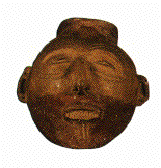 Cahokia
and the Mississippi Mound Builders
Cahokia
and the Mississippi Mound Builders
Phases of Cahokia
 Cahokia
and the Mississippi Mound Builders
Cahokia
and the Mississippi Mound Builders
Although there is ongoing debate about the dates for these periods and the need to continue refining them, following is a summary of the current thought on the four phases of Cahokia.
The Lohmann Phase (A.D.
1000/1050 to 1050/1100)
This phase saw the appearance of
town and mound centers. The first layer of Monks
Mound, the largest and most central mound in Cahokia, was begun during
this period. This was a time of political, religious, and social
transformation from that of the Emergent Mississippian period. Large
public projects were begun during this time. The first evidence of social
stratification was seen, in the form of elaborate burials and evidence
of sacrifices. Exotic items have also been found that are thought
to date to this period, which is taken as further evidence of social stratification
(with the elite controlling access to these items).
The Stirling Phase (A.D.
1050/1100 to 1150/1200)
Regional population peaked during
this phase, with increases estimated to be from as little as 4% to as high
as 53% from Lohmann phase populations. Households were thought
to be more abundant, but with fewer number of people in each household.
This was a time of major expansion, with increased construction and construction
of structures meant to have different functions. The abandonment
of some outlying areas was seen, with more of a concentration of population
in the urban center. The first evidence of craft specialization is
seen in the Stirling Phase.
The Moorehead Phase
(A.D. 1150/1200 to 1250/1275)
Regional population declined an
estimated 38-40% from the Stirling Phase. The final layer had
been put in Monks Mound during this phase. There may have been a
phase between Stirling and Moorehead that is yet to be identified.
The Sand Prairie Phase
(A.D. 1250/1275 to 1400/1350)
Not much is known about this period,
during which population continued to decline (as much as 43 to 37% of Moorehead
population levels according to Milner) and the regional structure was disintegrating.
The scant evidence points to minimal activity at Cahokia during the Sand
Prairie Phase.